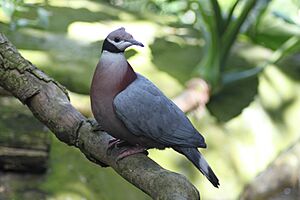Collared imperial pigeon facts for kids
Quick facts for kids Collared imperial pigeon |
|
|---|---|
 |
|
| At San Diego Zoo, San Diego, USA | |
| Conservation status | |
| Scientific classification | |
| Genus: |
Ducula
|
| Species: |
mullerii
|
| Synonyms | |
|
Ducula müllerii (lapsus) |
|
The collared imperial pigeon (scientific name: Ducula mullerii) is a big, beautiful bird that lives in New Guinea and nearby islands. It's a type of pigeon, but much larger than the ones you might see in a city park!
What Does It Look Like?
This pigeon is quite large, growing to about 40 centimeters (about 16 inches) long. It weighs around 600 grams (about 1.3 pounds), which is similar to a small chicken.
Its back and wings are mostly grey. Its belly and chest are a pretty grey-pink color. The most special thing about this pigeon is the clear black band, or "collar," around its neck. This black collar stands out against its white throat, making it easy to spot!
Where Does It Live?
The collared imperial pigeon makes its home in New Guinea and the Aru Islands. You might also find it on smaller islands like Boigu and Saibai. Sometimes, it might even fly to the northern Torres Strait islands for a visit.
These pigeons love to live in different kinds of forests. They can be found in lowland rainforests, swampy forests, and even in areas with mangrove trees. They also enjoy living near rivers.
What Does It Eat?
The collared imperial pigeon mainly eats fruit from forest trees. It also enjoys munching on insects.
In some areas, like near Port Moresby, these pigeons especially love a fruit called Tristiropsis canarioides. This fruit can make up almost half of their diet! They also eat fruits from the ylang-ylang tree (Cananga odorata) and different kinds of palm trees.
These birds swallow their food whole. They can even swallow fruits that are as big as 5 centimeters (about 2 inches) across!
How Does It Nest?
When it's time to lay eggs, the collared imperial pigeon builds a simple nest. It's usually a flimsy platform made of twigs, high up in a forest tree. These trees are often found next to wetlands. The female pigeon typically lays just one egg at a time.


